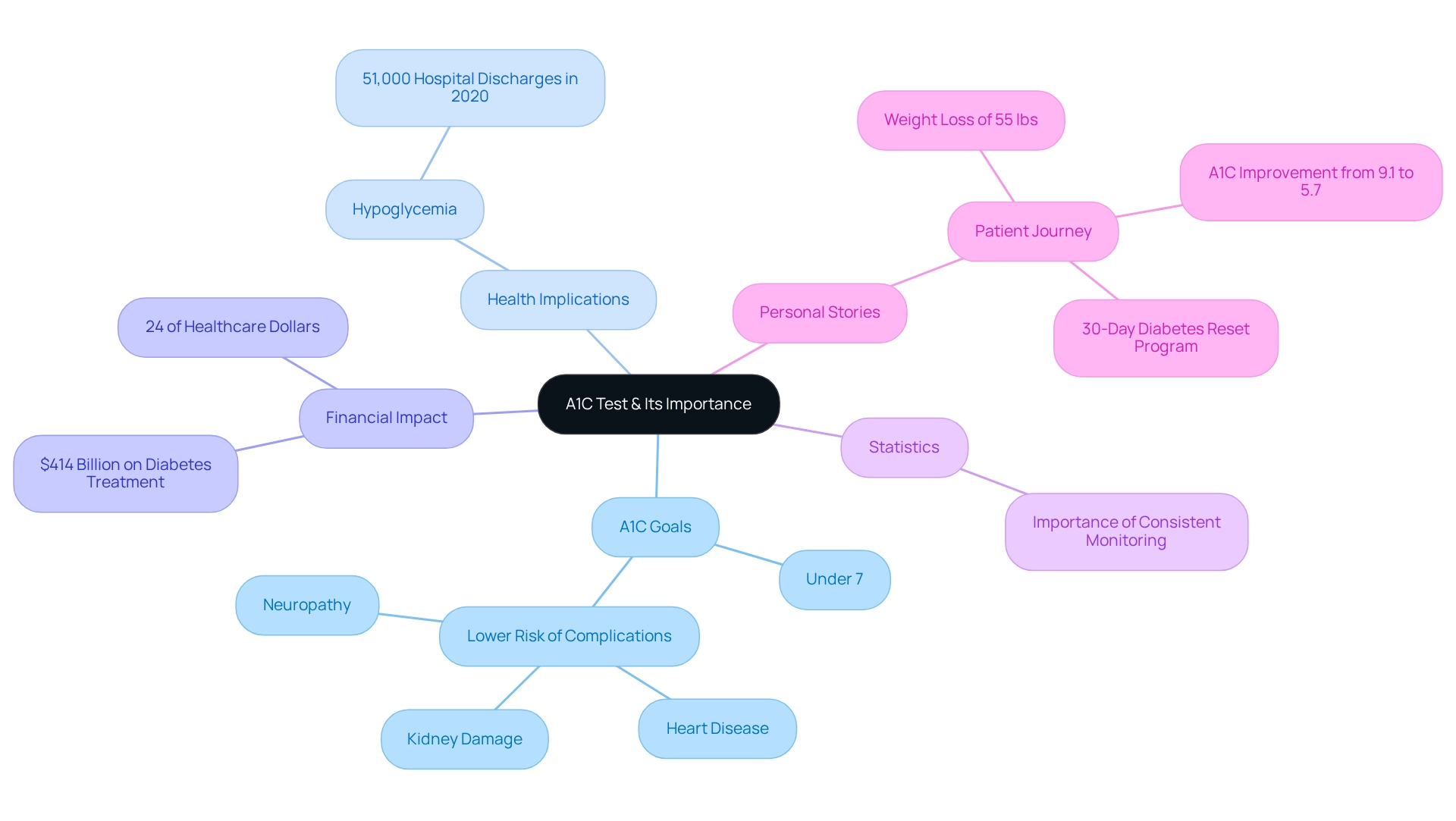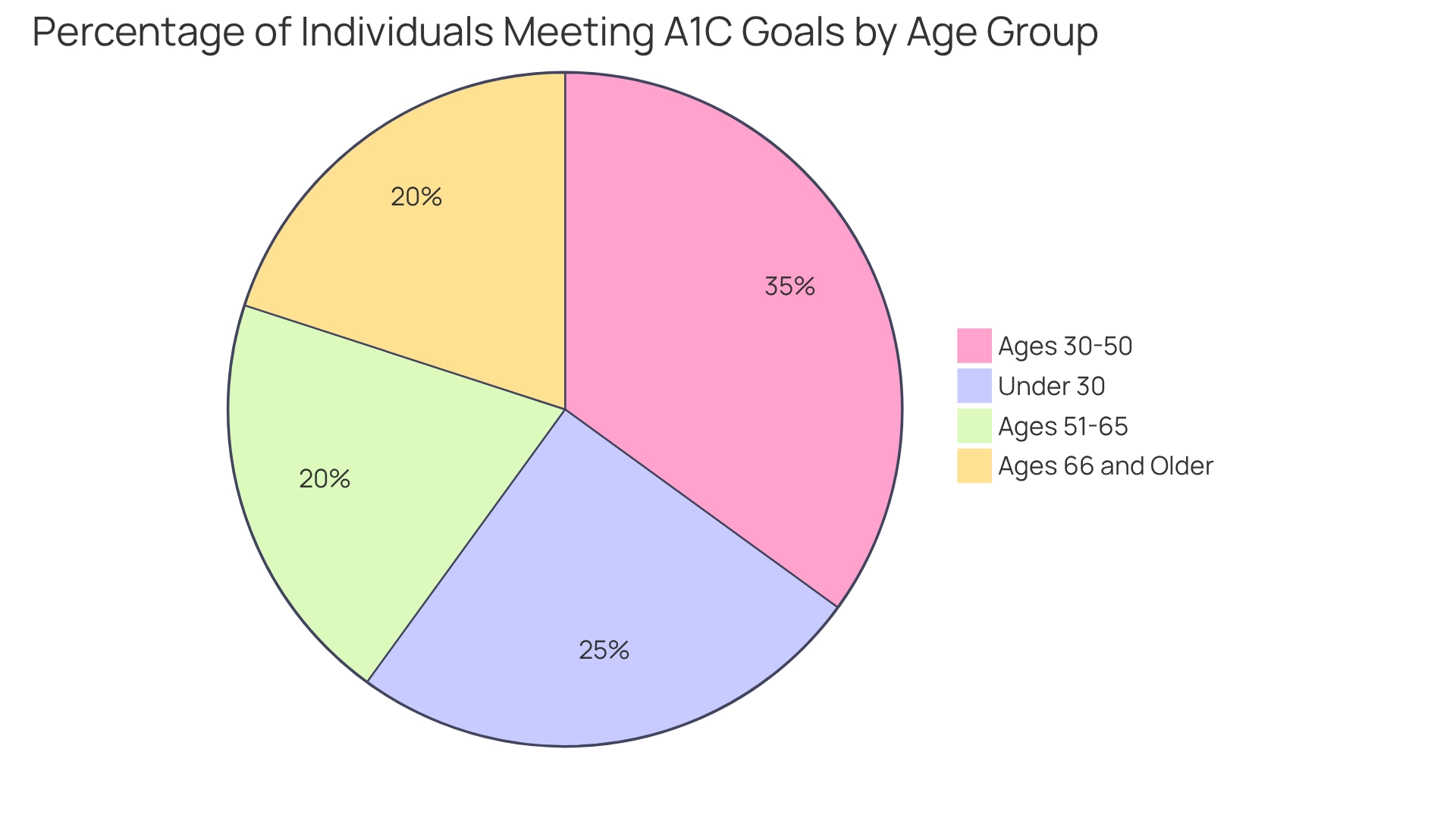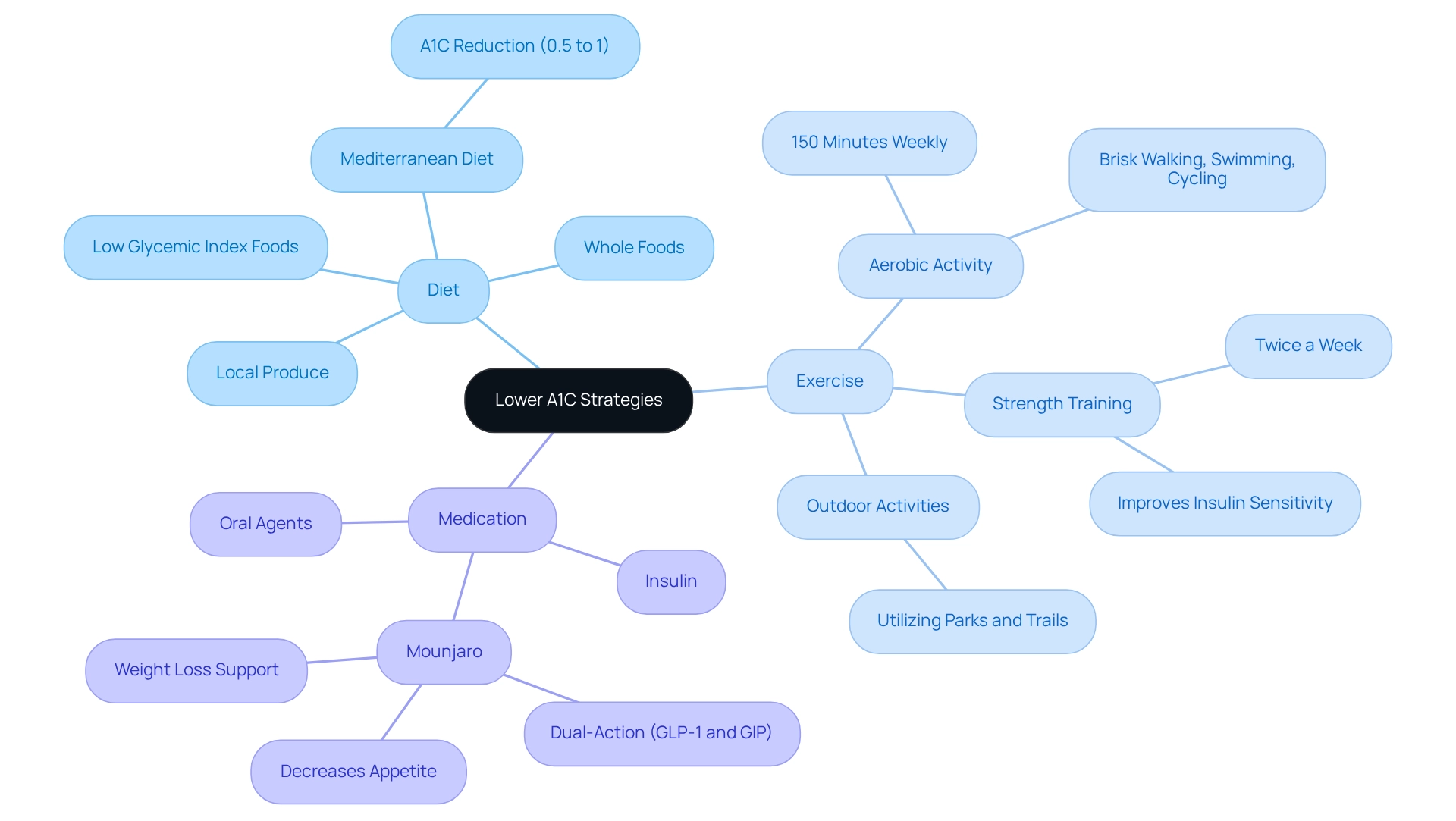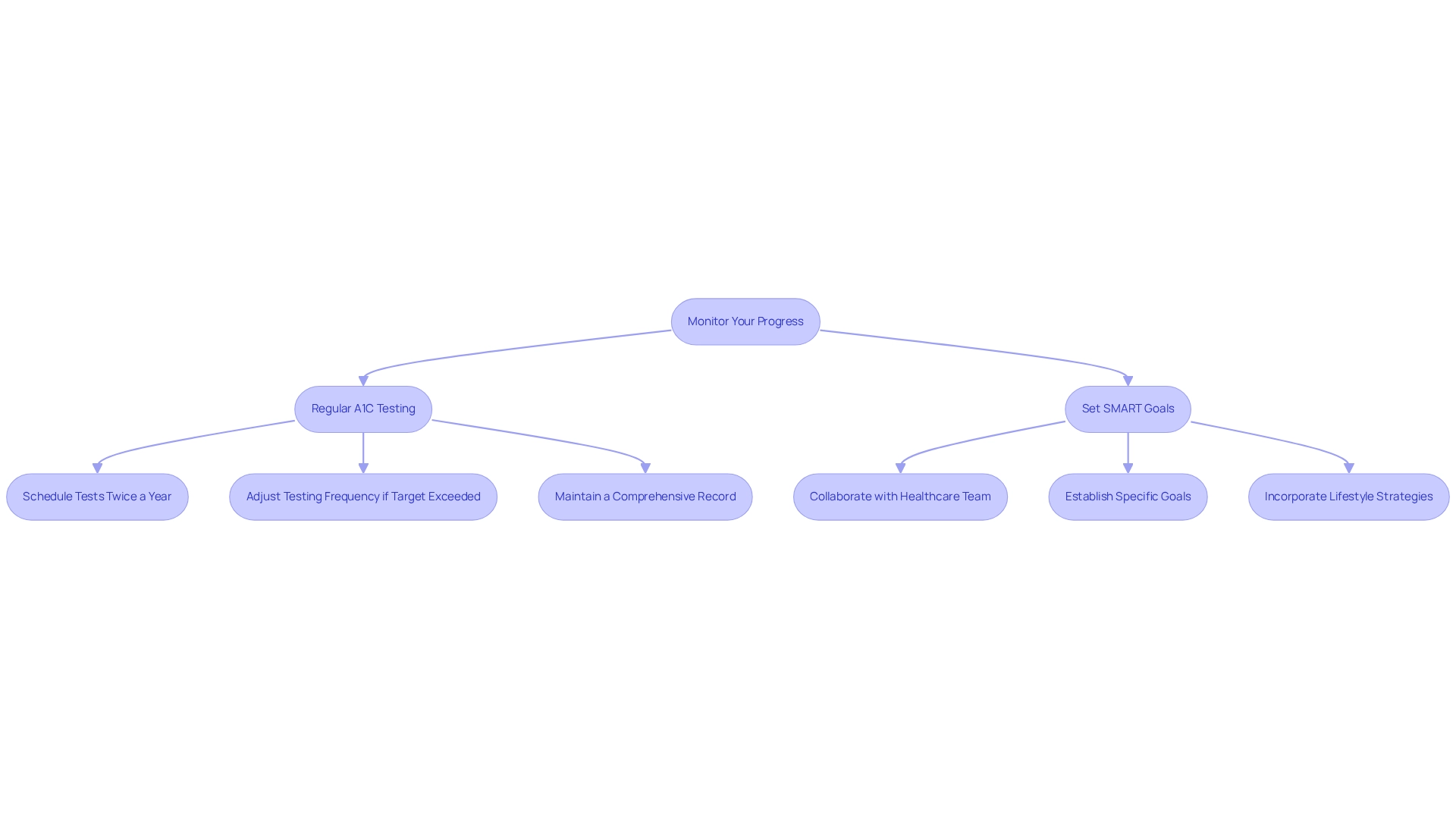Overview
Managing diabetes and achieving your A1C goal can feel overwhelming at times. It’s important to recognize that understanding A1C levels is the first step towards setting personalized targets.
By implementing effective strategies—like a balanced diet, regular exercise, and consistent monitoring—you can take control of your health. Many patients find that consistent A1C testing, paired with tailored lifestyle changes, significantly improves their blood sugar control. This not only reduces the risk of complications but also enhances the overall quality of life.
Remember, you are not alone on this journey. Embracing these changes can lead to a healthier, happier you. Have you considered how small adjustments can make a big difference? Let’s explore these strategies together, focusing on what works best for you.
Introduction
In the realm of diabetes management, it’s important to recognize the significance of A1C levels for maintaining optimal health. The A1C test serves as a vital indicator of your average blood sugar control over the past few months. This understanding can guide you in your journey to prevent complications associated with diabetes. Many individuals find that aiming for a target of less than 7% can feel daunting, but remember, regular monitoring and personalized strategies are key to your success.
As the healthcare landscape continues to evolve, embracing tailored approaches that encompass diet, exercise, and medication can truly empower you to take charge of your health. This article delves into the essentials of A1C management, offering insights and actionable strategies to enhance your diabetes care and improve your overall well-being. Together, we can navigate this journey toward healthier living.
Understand A1C: What It Is and Why It Matters
The A1C test, often known as hemoglobin A1C, plays a vital role in managing blood sugar conditions by assessing average glucose levels over the past two to three months. When expressed as a percentage, higher A1C values indicate poorer blood sugar control.
It’s important to recognize that the American Diabetes Association recommends an A1C goal for diabetes of under 7% for most adults living with this condition, as achieving this A1C goal is associated with a lower risk of complications such as heart disease, kidney damage, and neuropathy. Understanding your A1C level is crucial for evaluating the effectiveness of your management plan. Regular monitoring allows you to make timely adjustments to treatment strategies, ensuring optimal health outcomes.
Many patients find that being aware of the financial implications is also motivating; approximately 24% of all healthcare dollars—around $414 billion—are spent on treating diabetes, as highlighted by Maria Masters. This underscores the importance of effective management strategies.
Recent statistics reveal that in 2023, there were 51,000 hospital discharges due to hypoglycemia among adults with this condition, emphasizing the critical need for consistent A1C testing. Consistent monitoring can help prevent such hospitalizations by enabling proactive adjustments in treatment.
For instance, one patient shared their inspiring journey of losing 55 lbs and significantly improving their A1C from 9.1 to 5.7 after participating in Dr. Jason Shumard’s 30-Day Diabetes Reset program. This transformative experience illustrates the power of personalized nutrition and testing in reversing type 2 diabetes, highlighting the importance of setting an A1C goal and implementing effective strategies for progress tracking to minimize complications and enhance your overall quality of life.
Remember, you’re not alone on this journey; support and guidance are available to help you thrive.
Determine Your A1C Target: Recommended Goals for Type 2 Diabetes
Establishing your A1C goal for diabetes is a crucial step in managing type 2 diabetes effectively. It’s important to recognize that consulting with your healthcare provider is essential, as individual goals can vary significantly based on factors such as age, overall health, and the presence of other medical conditions. The American College of Physicians (ACP) recommends that most adults with type 2 diabetes aim for an A1C level between 7% and 8%. This recommendation is based on evidence indicating that lower targets do not necessarily enhance health outcomes and may even present risks, especially for specific populations, as emphasized in ACP’s guidance on glucose control.
Many patients find that for older adults or those with a history of severe hypoglycemia, a higher target of 7% to 8% may be more appropriate. Engaging in open discussions with your healthcare team is vital to establish a realistic and achievable A1C goal for diabetes that aligns with your health status and lifestyle. As Dr. Jack Ende, President of the ACP, notes, “Although ACP’s guidance statement focuses on drug therapy to control blood sugar, a lower treatment target is appropriate if it can be achieved with diet and lifestyle modifications such as exercise, dietary changes, and weight loss.”
Integrating comprehensive lifestyle techniques, like those offered in San Marcos, CA, can greatly improve your management of blood sugar. Embracing outdoor activities, focusing on a balanced diet rich in local produce, and participating in community wellness programs can empower you to achieve your A1C goals. Customized A1C goals for diabetes are increasingly recognized as essential for effective management of blood sugar levels, enabling adjustments based on individual circumstances.
Statistics show that over 30 million Americans have this condition, with 90 to 95 percent identified as having type 2, an ailment that is increasingly impacting younger demographics. Understanding the percentage of patients meeting A1C goals by age group can provide insight into the effectiveness of current management strategies. As healthcare providers emphasize individualized care, it’s crucial to consider factors such as diet, exercise, and overall health when establishing A1C goals for diabetes. Additionally, the ACP recommends de-intensifying drug therapy for patients with A1C levels below 6.5%, further underscoring the importance of personalized treatment goals. By tailoring these goals to your unique situation and integrating lifestyle changes, you can enhance your diabetes management and improve your overall quality of life.
Implement Strategies to Lower Your A1C: Diet, Exercise, and Medication
To effectively lower your A1C goal diabetes, it’s important to consider some supportive strategies that can make a real difference in your health journey, including emphasizing a balanced diet. Focus on whole foods like vegetables, lean proteins, whole grains, and healthy fats. Reducing processed foods, sugary drinks, and high-carb snacks is essential. Have you thought about incorporating low glycemic index foods? They can really assist in stabilizing glucose levels. Research shows that individuals adopting a Mediterranean diet can lower their A1C levels by approximately 0.5% to 1% over six months. Additionally, including seasonal fruits and vegetables from local farmers’ markets can enhance your diet with fresh, nutritious choices that support maintaining healthy levels.
Exercise: Regular physical activity is vital for managing glucose levels. Aim for at least 150 minutes of moderate aerobic exercise weekly—activities like brisk walking, swimming, or cycling are excellent choices. Many patients find that utilizing the beautiful parks and trails in San Marcos for their walking routine not only boosts their mood but also helps manage blood sugar levels. Furthermore, incorporating strength training activities at least two times per week can improve insulin sensitivity, which is essential for managing blood sugar levels. Studies have shown that consistent exercise can lead to a reduction in A1C levels by about 0.6% to 1% over a three-month period, helping individuals reach their A1C goal diabetes. Following your healthcare provider’s instructions regarding prescribed medications, including insulin or oral hypoglycemic agents, is also key. Open discussions about any side effects or concerns can help optimize your blood sugar management plan. Have you considered discussing the potential benefits of Mounjaro? This dual-action medication mimics GLP-1 and GIP, and it has been shown to decrease appetite and support weight loss, further aiding in A1C reduction.
Monitoring: Regularly checking your blood sugar levels is essential to understand how your body reacts to various foods and activities. This practice empowers you to make informed decisions about your diet and exercise, ultimately supporting your A1C goal diabetes of lowering A1C levels. Furthermore, monitoring your progress via a journal or an application can sustain motivation and help you acknowledge your accomplishments throughout this journey.
By implementing these strategies, you can take proactive measures toward managing your condition and enhancing your overall health. Incorporating insights from nutritionists, such as the importance of meal timing and portion control, can further enhance your approach to lowering A1C.
Monitor Your Progress: Track A1C Levels and Adjust Your Plan
To effectively monitor your progress, it’s important to recognize that managing diabetes can feel overwhelming at times. Here are some compassionate steps to help you on your journey:
-
Regular A1C Testing: Scheduling your A1C tests at least twice a year is crucial for achieving your A1C goal diabetes and maintaining stable levels. If your A1C exceeds your target, more frequent testing—typically every three months—may be necessary to evaluate how well your management plan is working. This regular assessment helps you make timely adjustments to your treatment strategy. Many patients find that maintaining regular A1C testing can significantly improve their diabetes management outcomes, especially when combined with structured approaches to reach their A1C goal diabetes. Keeping a comprehensive record of your readings allows you to recognize patterns and understand the factors affecting your glucose levels. This practice not only aids in understanding your condition better but also empowers you to take charge of your health. Don’t hesitate to ask your physician about your target glucose range and how to enhance or maintain your glucose levels. Engaging in community wellness programs can provide additional support tailored to your needs. Consider using fitness applications or journals to track your daily activities and glucose levels, which can further improve your awareness and responsibility.
-
Set SMART Goals: Collaborate with your healthcare team to establish SMART goals—specific, measurable, attainable, relevant, and time-bound—based on your A1C results and daily glucose readings to reach your A1C goal diabetes. For example, you might aim to reduce your A1C by a certain percentage within a specific timeframe or increase your physical activity by a set number of minutes each week. This customized strategy ensures that your management plan adapts to your health requirements, enhancing your condition control. Key questions to discuss with your doctor include your target blood sugar range, the frequency of checks, and the meaning of your blood sugar numbers. Incorporating holistic lifestyle strategies, such as focusing on a balanced diet rich in local produce and regular outdoor exercise, can further enhance your management efforts.
Remember, regular A1C testing and diligent self-monitoring are essential components of effective diabetes management, significantly impacting your overall health outcomes. By staying informed and proactive, you can navigate your journey toward achieving your A1C goal diabetes with confidence and support.
Conclusion
Understanding and managing A1C levels is essential for individuals living with diabetes. It’s important to recognize that the A1C test serves as a crucial measure of average blood sugar control, with a recommended target of less than 7% for most adults. Regular monitoring and personalized strategies are vital in preventing complications and improving overall health. Many patients find that consistent testing and proactive management can significantly enhance their well-being.
Establishing realistic A1C goals tailored to individual health circumstances is vital. Engaging in discussions with healthcare providers can lead to personalized targets that consider factors like age and overall health. It’s encouraging to see how integrating holistic lifestyle changes, such as balanced nutrition and regular physical activity, plays a significant role in achieving these goals. Additionally, the importance of medication adherence and self-monitoring cannot be overstated, as these practices empower individuals to understand their bodies better and make informed decisions.
In conclusion, taking charge of diabetes management through informed A1C monitoring, personalized goal setting, and lifestyle modifications can truly empower individuals to enhance their well-being. By prioritizing these strategies, the journey towards better health becomes not only achievable but also sustainable. Remember, every small step counts, ultimately leading to improved quality of life and a reduced risk of complications associated with diabetes.
Frequently Asked Questions
What is the A1C test and why is it important?
The A1C test, also known as hemoglobin A1C, measures average glucose levels over the past two to three months. It is important for managing blood sugar conditions as it helps assess blood sugar control and evaluate the effectiveness of management plans.
What A1C level is recommended for most adults with diabetes?
The American Diabetes Association recommends an A1C goal of under 7% for most adults living with diabetes, as achieving this level is associated with a lower risk of complications such as heart disease, kidney damage, and neuropathy.
How can regular A1C monitoring benefit patients?
Regular A1C monitoring allows patients to make timely adjustments to their treatment strategies, ensuring optimal health outcomes and helping to prevent complications related to diabetes.
What are the financial implications of diabetes management?
Approximately 24% of all healthcare dollars, around $414 billion, are spent on treating diabetes. Understanding these financial implications can motivate patients to adopt effective management strategies.
What recent statistics highlight the importance of consistent A1C testing?
In 2023, there were 51,000 hospital discharges due to hypoglycemia among adults with diabetes, emphasizing the need for consistent A1C testing to prevent such hospitalizations through proactive treatment adjustments.
Can personal experiences illustrate the impact of A1C management?
Yes, one patient improved their A1C from 9.1 to 5.7 and lost 55 lbs after participating in Dr. Jason Shumard’s 30-Day Diabetes Reset program, demonstrating the effectiveness of personalized nutrition and testing in reversing type 2 diabetes.
What support is available for individuals managing diabetes?
Individuals managing diabetes can find support and guidance to help them thrive on their journey towards better health and A1C management.



